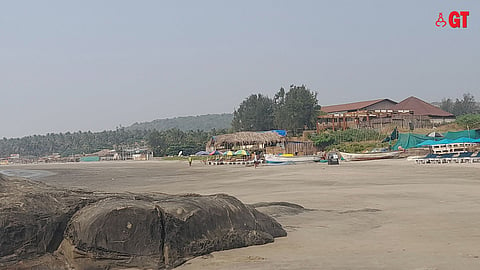

On December 27, 2023, at around 8.30 pm, two forest guards, patrolling Morjim beach, noticed a turtle walking towards the shore. From a distance, they followed cautiously and watched as the turtle found a spot, laid its eggs, returned to the sea and swam away.
“The turtle laid 92 eggs, and after it disappeared, we dug out the eggs and relocated them at the site created by us. This was the first turtle to lay eggs this season,” explained Raj, who has been working for the Forest Department turtle nesting site in Morjim for the last 20 years.
A few days later, January 2, 2024, saw two turtles walking up the shore -- one laid 93 eggs at 12 am, and the other 101 eggs at 4 am, thus bringing the total number of eggs laid to 268 in a span of five days.
Raj, a fisherman from Morjim, gave up his profession in the year 2000 to look after turtles. “In my younger days, there were no shacks around and we used to see turtles when we went fishing. They were natural occurrences then,” reminiscences Raj.
Turtles begin to lay their eggs in December, the season peaks from January to February, and they stop coming once the temperature begins to rise.
The forest Department has a team of six patrolling the shore, looking for turtles coming to lay eggs, and later relocating them for hatching and releasing the hatchlings into the water.
“We had 69 turtles that came to lay their eggs last season, and we released around 4,000 hatchlings into the sea. Depending on the temperature, the eggs normally take around 42 to 52 days to hatch,” admits Raj, who finds turtles interesting to observe.
All the eggs are brought to a barricaded site, created by the Forest Department, and once the hatchlings come out, they are taken and left a little before the High Tide Line (HTL) just before the shore, “or else they miss the place from where they were born,” reasons Raj.
The first turtle to lay its eggs was observed a kilometer away from the Forest Department nesting site, closer to shacks and restaurants on the beach.
“We first observed that the turtle had moved 90 meters from the HTL and tried to dig its hole. Somehow, it stopped after a few attempts and walked back another 20 metres, laid its eggs and disappeared into the sea,” observed Raj.
“The turtle could have changed its spot because it might have found something unpleasant under the surface of the sand,” reasons Raj.
There are a lot of misconceptions regarding turtle nesting, thinks Raj who believes that most turtles prefer to come on the shore at a spot where the river meets the sea – and at Morjim, it is at Tembwada, the mouth of the Chapora river.
The Olive Ridley Project was started in Morjim by the Forest Department in 1997, and the number of turtles coming to lay eggs has been on the rise since then.
There is a common misconception that turtles are averse to glaring light, reasons Raj and to substantiate this, he points out that in Candolim, a turtle came twice to lay eggs under a light post on the beach, thus rubbishing claims that they are averse to light.
“Lights distort the hatchlings, but not turtles. Hatchlings tend to go towards the lights instead of the sea, and can get killed in the bargain,” explains Raj.
“Turtles are not bothered by the presence of humans if they are not disturbed,” assumes Raj.
“If a turtle feels it is time to lay its eggs, it will go anywhere. That is a biological necessity that is not determined by social settings,” argues Raj, who believes activists tend to exaggerate matters related to turtle nesting sites.
“Turtles,” according to Raj, “normally come on shore to lay their eggs during the high tide at night. If the tide is low at night, but there is a North breeze, it also pushes them to the shore.”
Raj believes that being a fisherman has given him a better understanding of turtle nesting.
On seeing a turtle walking onto the shore, forest department officials first check whether the turtle has black flippers.
“There are times when some turtles don’t have back flippers, and so, digging a hole, to lay the eggs, becomes difficult,” says Raj.
When turtles without back flippers are spotted, forest officials crawl behind the turtle, and with their hand, make up for the lost back flipper. “We dig with our hand, and thus, help the turtle make a complete hole,” admits Raj.
“When we started the project, we had just four nests. The numbers have increased ever since, and that is because we have worked along with the people in the shack business,” admits Raj.
“We should work hand in glove with business people. We should not discard them,” reasons the man for whom turtles can be best studied through observation, and who says, “Turtles have no sense of hearing. They sense through vibrations.”